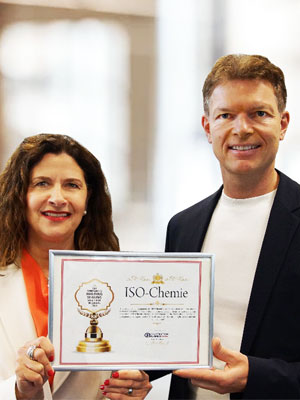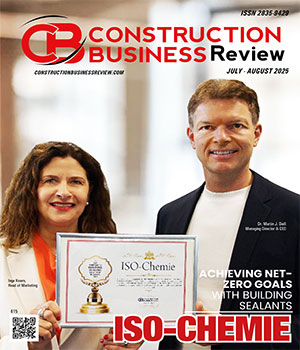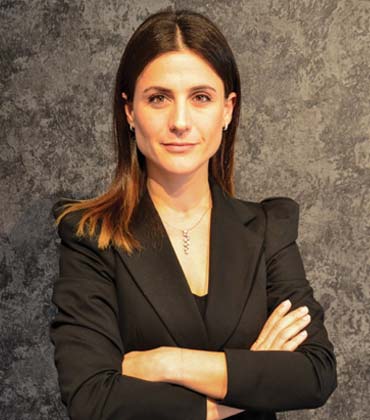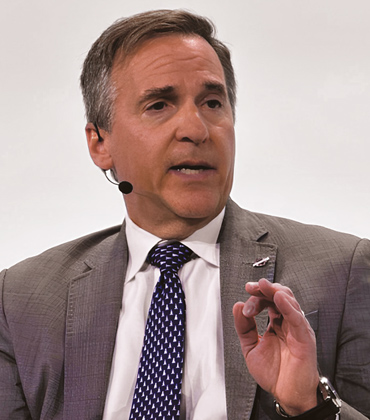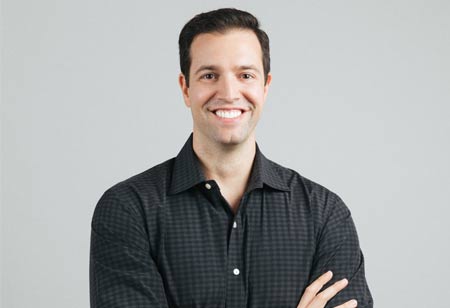Thank you for Subscribing to Construction Business Review Weekly Brief
A mere 3mm gap around a window frame can leak as much heat as leaving the window open an inch all day. In construction, these invisible openings silently disrupt energy efficiency efforts. But with the leaders of sealing technology—ISO-Chemie—in the picture, it’s not just the gaps that get plugged; a new wave of sustainability is ushered in, transforming inefficiencies into opportunities for environmental benefit. For over 45 years, the company has been a frontrunner in the European market, developing, producing and distributing energy-efficient and sustainable building sealing solutions. Its products not only save energy, but are sustainably produced, which positions it as a key player in the evolving landscape of building regulations and energy standards. This innovation couldn’t be timelier. The revised Energy Performance of Buildings Directive (EPBD) is part of the European Union’s ‘Fit for 55’ package, which aims for a zero-emission building stock by 2050. It’s an unprecedented challenge for the construction industry. ISO-Chemie’s solutions are designed to meet these goals, including minimum energy performance standards crucial for reaching the first initiative; reducing greenhouse gas emissions by at least 55 percent by 2030. Many clients have used ISO-Chemie for decades and continue using it for its eco-friendly products and ability to address common installation challenges. Customers consistently seek versatile, easy-to-use solutions. ISO-Chemie’s research and development team prioritises superior physical properties to ensure its solutions meet diverse needs, making them efficient and reliable. Sealing Excellence with Smart Innovation The company’s innovation shines through in its diverse product range, designed for applications from window and wall installations to industrial and commercial construction, as well as metal facade and timber house construction. Each product is crafted with a focus on convenience, versatility and eco-friendliness. To bring these innovative products to market, ISO-Chemie blends the latest manufacturing techniques with visionary thinking and decades of sealing technology expertise. The development team works tirelessly to stay ahead of industry demands, a commitment reflected in the numerous patents the company holds. “We are very pleased to have introduced nearly 70 patent families with numerous individual applications,” says Dr. Martin J. Deiß, managing director and CEO of ISO-Chemie.
Top Modular Construction Services Providers
Produktif, a design and technology company rooted in the construction industry, is accelerating the transition to circular construction by prioritizing the sustained value of products, components, and resources. The firm’s primary mission is to develop purpose-engineered connectors for building elements, honed through collaborations in the modular construction sector. At the forefront of its innovation are Click/Unclick C-Joint and O-Joint, patent-pending, and pivotal components of the Click/Unclick joinery system. These inventions enhance the speed of assembling and disassembling building components while enabling complete material reusability in construction practices. “Through our innovative approach to assembly and disassembly, we are set to redefine the standards that the EU Commission holds for construction, paving the way towards a more sustainable future,” says Rune Kongshaug, CEO and co-founder of Produktif. In an industry known for its traditional practices, Produktif’s ethos is based on a unique approach that combines innovative technological solutions with a commitment to environmental sustainability, speed, and collaboration across the construction value chain. The outlined approach also serves as a powerful tool for Produktif in addressing the substantial challenges plaguing the construction sector. These encompass the considerable $1.6 trillion productivity gaps, persistent shortages of skilled labor and concerns about environmental repercussions. The inability to meet the rising demand for affordable housing exacerbates these issues. In response, Produktif has taken a radical approach, reshaping the construction value chain by eliminating hand tools and decentralizing decisions from the construction site, enabling builders to assemble structures four times faster. In addition to addressing the industry’s significant contributions to energy consumption, greenhouse gases, and landfill waste, Produktif intends to reengineer the value chain. It prioritizes the reuse, upcycling, and recycling of construction components, ensuring that 100 per cent of building elements are designed for multiple lifecycles. At the core of Produktif’s transformative solutions lies its patented Click/Unclick system, comprising two essential components. The first, Design for Assembly and Disassembly (DFAD), is a process that thoroughly evaluates construction systems and strategically selects reusable materials tailored for diverse construction typologies. By employing this methodology, the company promotes a sustainable approach that focuses on the materials’ life cycle, fundamentally reshaping how they are utilized and repurposed within the construction industry.
Top Precast Concrete Services
Kambeton serves as a one-stop shop for all concrete needs, offering the most comprehensive range of precast products across Turkey and Europe. With six distinct product categories and an extensive selection of 3,000 items, the company operates three state-of-the-art facilities covering a combined production area of 290,000 square meters. This infrastructure enables Kambeton to achieve an impressive annual production capacity of 360,000 cubic meters of concrete. “We can design and manufacture all kinds of concrete products in bulk, from infrastructure to superstructure elements, based on customized needs,” says Beril Baykam Paksoy, vice chairman of the board. Led by its founder, Zeki Baykam, alongside second-generation leaders Beril Baykam Paksoy and İdil Baykam, Kambeton has amassed over 45 years of expertise in concrete manufacturing. Supported by a proficient in-house team, with 35 percent of its professionals possessing over a decade of experience, it offers a diverse range of products, including prestressed beams, columns, hollow-core slabs, retaining blocks, box culverts, and more. Employing a vertically integrated approach ensures maximum efficiency and reliability for each product, enabling Kambeton to oversee every aspect of the project, from inception to completion. Kambeton’s ability to fabricate its formworks enables precise customization and quality control. A specialized fleet of trucks and cranes ensures efficient material handling, while highly skilled in-house installation teams execute innovative, customized designs developed by the seasoned design team. This self-reliant approach enables the company to meet tight deadlines. The in-house R&D team constantly explores new technologies and materials to improve the performance and aesthetics of precast concrete. Their efficiency was proven during the 2023 Turkey earthquake when they developed Betokon, a worksite container combining a durable concrete base with an insulated steel top.This innovation provided a superior housing solution for those displaced by the disaster, addressing rust and flood damage issues that affected steel containers. Kambeton prioritizes quality above all else and has access to high-quality raw materials due to its advantageous geographic location. It has been an active member of the Precast Association of Turkey since 1994 and is accredited by K-Q TSE-ISO-EN-9001:2015. The production processes adhere to industry standards, and all products undergo meticulous testing to ensure the delivery of best-in-class concrete components that surpass client’s expectations. Building long-lasting relationships with clients requires going out of the box to accommodate their needs, and Kambeton does it like no one else. One of Turkey’s biggest conglomerates once approached it for the construction of a paper mill factory. The client had a tight deadline and wanted the company to take charge of the precast and the entire construction phase. Through meticulous planning and resource allocation, the project was completed on time.
Construction Equipment and Engineering Services
When driving across the Bay Bridge in San Francisco or admiring the towering 726-foot Hoover Dam, we often marvel at their historical significance. But do we ever consider the company behind these engineering feats? It’s none other than Bechtel, a global leader in infrastructure development. Since its founding in 1898, Bechtel has completed over 25,000 projects in 160 countries across all seven continents. Its impact is worldwide, from power plants to transportation networks, shaping economies and connecting nations. It’s Not Just Construction, It’s Smart Construction Success in large infrastructure projects goes beyond building—it requires innovation. These endeavors involve vast subcontractor networks, thousands of workers and billion-dollar budgets. Decades of expertise enable Bechtel to manage complexities precisely, ensuring projects are completed efficiently and built for longevity. A key component of this success is supply chain management. With billions in annual expenditures, Bechtel ensures responsible materials sourcing, even in remote locations. Digital project management tools provide real-time tracking, seamlessly coordinating teams across the globe. Integrating scheduling, cost control and risk management keeps projects on time and within budget. Harnessing Technology for Faster Projects Technology is at the heart of Bechtel’s operations. The company employs cutting-edge innovations like 3D, 4D and 5D modeling, cloud-based solutions and mobile platforms to optimize project execution. These tools accelerate timelines, enhance efficiency and improve quality. “We must push these technologies down the cost curve by building more units. Once standardization and repetition are achieved, construction schedules are shortened and costs go down. This is true for every aspect of the project delivery, including engineering, permitting, manufacturing and construction,” says Craig Albert, President and COO.
CXO INSIGHTS

A Roadmap to Shaping the Future of Construction
Abdulmajid Karanouh, International Director, Head of Interdisciplinary Design & Innovation, Drees & Sommer
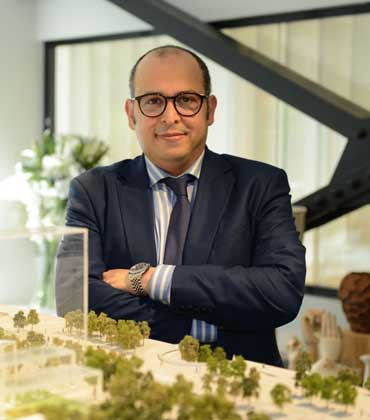
How Offsite Construction Bring Solutions for Sustainable Buildings?
Moad Ziadi, Southern Europe Project Management Director, Unibail Rodamco Westfield

Ever-Changing Trends in the Construction Industry
Frank Islas, Director of Structural Operations, OSBURN

Revolutionizing Construction: The Marvels of Modular Construction
Ivan Bevilacqua, Project Leader Control Italia, Impresa Pizzarotti & C. S.p.A.
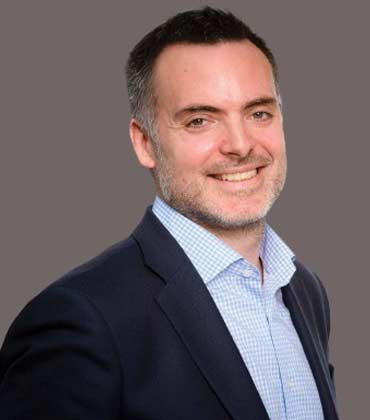
Upskilling The Workforce for Safer Offshore Operations
Matthieu Jaunatre, Head of QHSE Europe, Ørsted.

The Evolution and Modern Challenges of Prefabrication in Concrete Construction
Marco Bonomo, Head of Structural Department (UK & Ireland), TYPSA
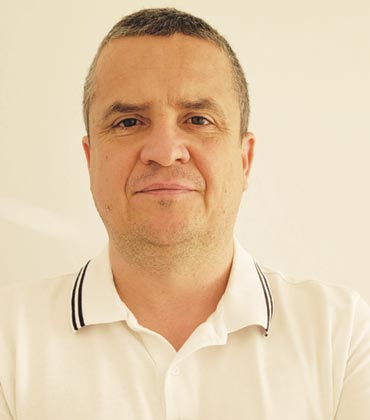
The Evolution and Future of Prefabricated Construction in Poland
Marcin Dudrak, Construction Manager at Gülermak Heavy Industries Construction & Contracting

Embracing Precast Concrete in Modern Construction
Stuart Marsh, Senior Associate Principal, Structural Engineer at Skidmore, Owings & Merrill (London)
IN FOCUS
EDITORIAL
Navigating the Changing Construction Landscape
The construction industry is experiencing exponential growth, fueled by increasing urbanization and infrastructure development across residential, commercial and industrial sectors. Technology advancements are streamlining processes and boosting productivity, creating more opportunities for innovation and investments. The demand for modern, efficient structures continues to rise globally, adding to the industry’s momentum. Decking is a standout area in this surge, which has witnessed vibrant and sustainable growth in recent years. Homeowners and builders are leaning toward custom living solutions made of composite and lowmaintenance materials. Eco-friendly decking options are taking center stage, and service providers are responding with full-suite offerings that include 3D design consultations, long-term maintenance programs and seamless installation. As developers prioritize energy efficiency and moisture control in structures, building envelope consultation services are becoming highly sought after. Advanced services like air leakage testing, thermal imaging and hydrothermal modeling enable better decision-making during design and retrofit phases. A leading trend is building envelope commissioning, which ensures materials and assemblies meet code and client expectations. These services support green building certifications and reduce long-term operational costs. Multi-family roofing is also evolving, concentrating on energy performance, scalability and integrated systems. Service providers now offer complete roofing packages where impact-resistant materials, solarready designs and enhanced insulation contribute to energy conservation. Technologies like drone inspections and AI-assisted leak detection are optimizing maintenance and quality assurance. Many roofing companies are directing efforts to improve preventive maintenance programs, allowing property managers to track roof health and extend lifespan with minimal disruption to residents. Sustainability initiatives, tailored solutions and new technologies are opening the doors for companies to lead with expertise, elevating client experiences and contributing to a more forward-thinking and efficient environment. In this edition of Construction Business Review, we explore the recent developments and leading trends in decking, multi-family roofing services and building envelope services. We also discuss how companies leverage cutting-edge technologies to stay abreast of challenges and potential potholes and establish a strong presence. We hope this edition of Construction Business Review helps you find the right partner for your business requirements. Let us know your thoughts!

